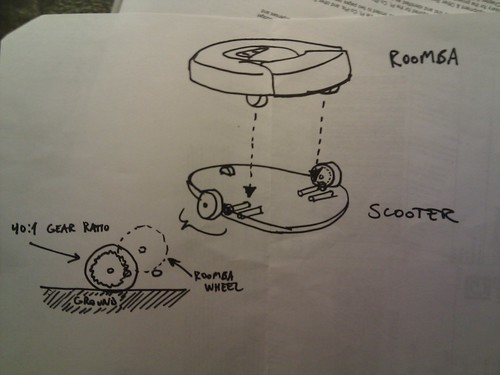
Roomba toxin mapping
Purpose
This tool is being developed to experiment with mapping indoor air quality. Roomba--the room cleaning vacuum--is programmed to travel all around a room once it is left to roam. Therefore, it is an ideal tool to assess the quality of air through out a room. We have attached a sensor and light system to these second hand Roombas. When our Roomba senses a change in air quality, currently an increase in the amount of volatile organic chemicals (VOC) in the air (we use alcohol as our test VOC) it emits a different color of light. If you take a long exposure image of our Roomba as it travels through a room, you can see the path its traveled by the light it emits. In areas where there are more VOCs the light on Roomba changes from green to blue. Looking at this image you can easily spot an area of indoor air-pollution. In the future we will be adding a sensor for formaldehyde to this Roomba. Formaldehyde is a very common indoor and harmful indoor air-pollutant.
Currently, we use MQ 135, an air quality sensor to express the condition of air. In the future, we can also use the wireless system or hack a roomba to control its movement as the quality of air.
Currently, there are very few tools for assessing one's indoor air-quality. Indoor airpollution has been linked to numerous disorders such as Asthma, and Sick Building Syndrome. Roomba is our first attempt to generate DIY tools for investigating one's home environment and producing data rich images that are easy to interpret.
Applications and example uses
Roomba is still in development. We aim for roomba to be useful individual homes and schools.
This annotated image shows the basic parts for our roomba v.1:

How to make your own
We are working on a step by step guide to Hacking your Roomba.
This image shows the basic parts of Roomba V.1:

Wiring for Roomba V.1 to connect VOC sensor to LED so the light color changes based on the sensor readings:

Close up image of wiring:

Arduino Code for VOC sensor in Roomba V.1:

How to use it
- Byeongwon used the Volatile Organic Chemical Sensor to detect a gas leak in his home: [[http://publiclaboratory.org/notes/bha/9-11-2011/gas-leak-old-apartment|using VOC sensor to locate an apartment gas leak]]
Get involved!
- Research is actively being done on this project by Jae Ok Lee and Byeongwon Ha in The RISD Environmental Justice Research Cluster in [Providence](/place/providence.
- and places to start contributing- -Hack your roomba! -Help us develop roomba documentation. -advise us on indoor air-pollution issues?
- List next steps:
- Our next step is to try a formaldehyde rather than VOC sensor on Roomba:[[http://publiclaboratory.org/notes/sara/12-13-2011/formaldehyde-sensing-indoor-air-pollution|More information on Formaldehyde]]
- We also aim to sync up Roomba's movements to the sensor speed. The Roomba moves much too fast to produce good readings -- the sensors take 15-30 seconds to detect anything -- so the group is working on a few ways to slow down the robot. One is to mechanically gear down the wheels with a kind of "scooter":
 The second is to use a more recent model of Roomba whose speed is programmable. We have purchased a Roomba 530 model and will be attempting to slow Roomba down computationally rather than mechanically.
The second is to use a more recent model of Roomba whose speed is programmable. We have purchased a Roomba 530 model and will be attempting to slow Roomba down computationally rather than mechanically.